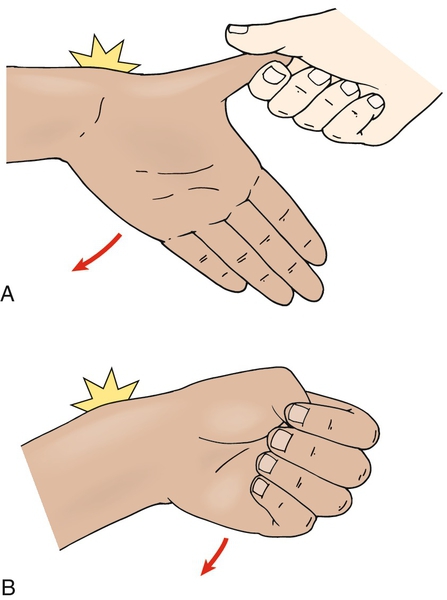CHAPTER 28
de Quervain Tenosynovitis
Definition
Tenosynovitis is inflammation of a tendon and its enveloping synovial sheath [7]. de Quervain tenosynovitis is classically defined as a stenosing tenosynovitis of the synovial sheath of tendons of the abductor pollicis longus and extensor pollicis brevis muscles in the first compartment of the wrist due to repetitive use [2]. Fritz de Quervain first described this condition in 1895 [3]. Histologic studies have found that this disorder is characterized by degeneration and thickening of the tendon sheath and that it is not an active inflammatory condition [8].
In fact, de Quervain described thickening of the tendon sheath compartment at the distal radial end of the extensor pollicis brevis and abductor longus [3]. Extensor triggering, which is manifested by locking in extension, is rare but has also been reported in de Quervain tenosynovitis with a prevalence of 1.3% [1].
Overexertion related to household chores and recreational activities including piano playing, sewing, knitting, typing, bowling, golfing, and fly-fishing have been reported to cause de Quervain tenosynovitis. Workers involved with fast repetitive manipulations such as pinching, grasping, pulling, and pushing are also at risk [6]. Excessive use of the text messaging feature on a cellular phone has now also been linked to this painful condition [9].
For a majority of cases, the onset of de Quervain tenosynovitis is gradual and not associated with a history of acute trauma, although several authors have noted a traumatic etiology, such as falling on the tip of the thumb [6].
de Quervain tenosynovitis primarily affects women (gender ratio approximately 10:1) between the ages of 35 and 55 years. There is no predilection for right versus left side, and no racial differences have been observed [6].
Symptoms
Patients may complain of pain in the lateral wrist during grasp and thumb extension [3]. They may also describe pain with palpation over the lateral wrist [10]. Symptoms are often gradual in onset and persistent for several weeks or months, and there is often a history of chronic overuse of the wrist and the hand [11]. Pain is the most prominent symptom quality, but some patients report stiffness as well. Pain is often described as severe and may be sufficiently intense to render the hand useless [6]. Paresthesia in the distribution of the anterior terminal branch superficial radial nerve is uncommon [6].
Physical Examination
On examination, the findings of local tenderness and moderate swelling around the radial styloid are likely to be present [11]. A positive Finkelstein test result can confirm the diagnosis [12]. The Finkelstein test is performed by grasping the patient’s thumb and quickly abducting the hand in ulnar deviation [4] (Fig. 28.1). Reproduction of pain is a positive test result. A similar test, described by Eichhoff in 1927, provides ulnar deviation while the patient is flexing the thumb and curling fingers around it. Pain should disappear the moment the thumb is again extended, even if the ulnar abduction is maintained [3]. The Eichhoff test is sometimes erroneously called the Finkelstein test. The Brunelli test maintains the wrist in radial deviation while forcibly abducting the thumb [3] (Fig. 28.2). Pain over the radial styloid from these provocative stretch maneuvers differentiates de Quervain tenosynovitis from arthritis of the first metacarpal joint [10]. Strength and sensation are expected to be normal in patients with de Quervain tenosynovitis. However, strength, particularly grip and pinch strength, may be decreased from pain or disuse secondary to pain [13]. A comprehensive examination of the neck and entire upper extremity should be performed before the wrist examination to rule out radiating pain from a more proximal problem, such as a herniated cervical disc [10]. Assessment of the first carpometacarpal joint, including range of motion, palpation for tenderness and crepitus, and radiographic investigation, should also be performed because injury to this joint can give a false-positive Finkelstein test result [14].








